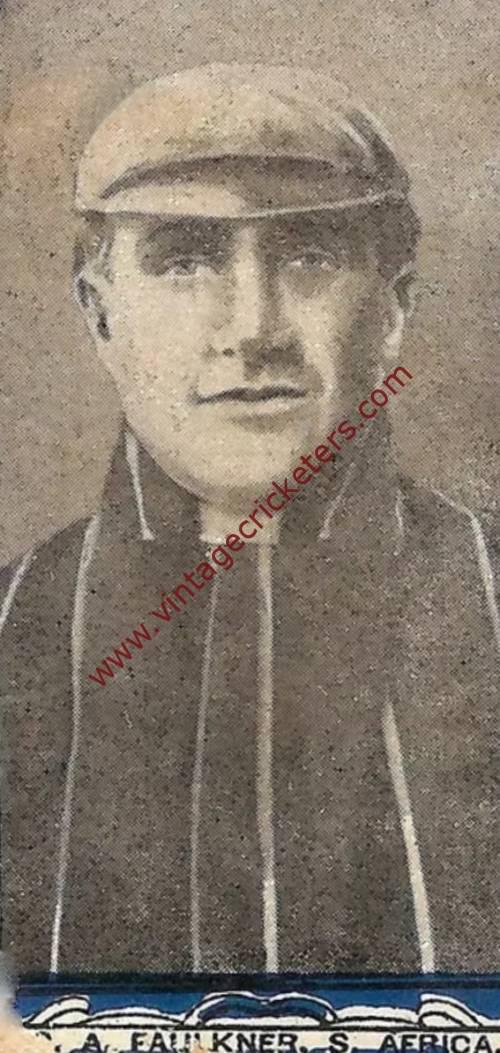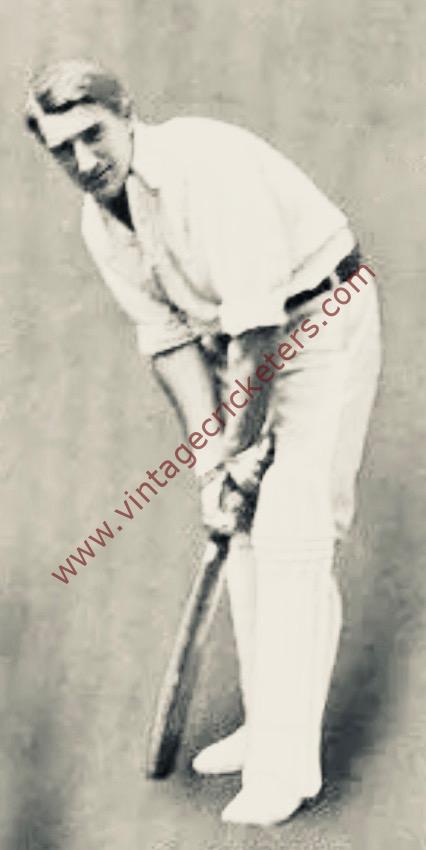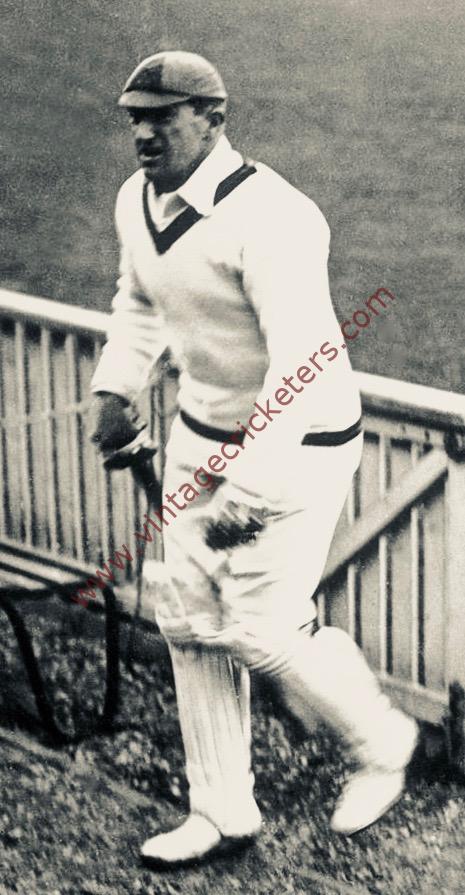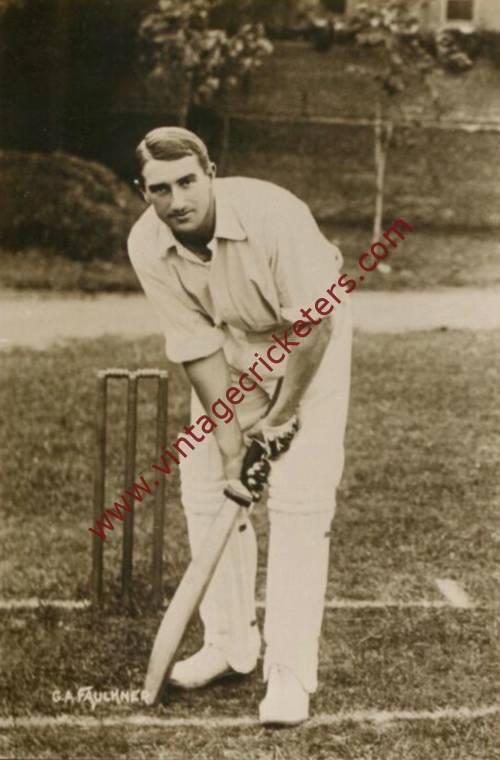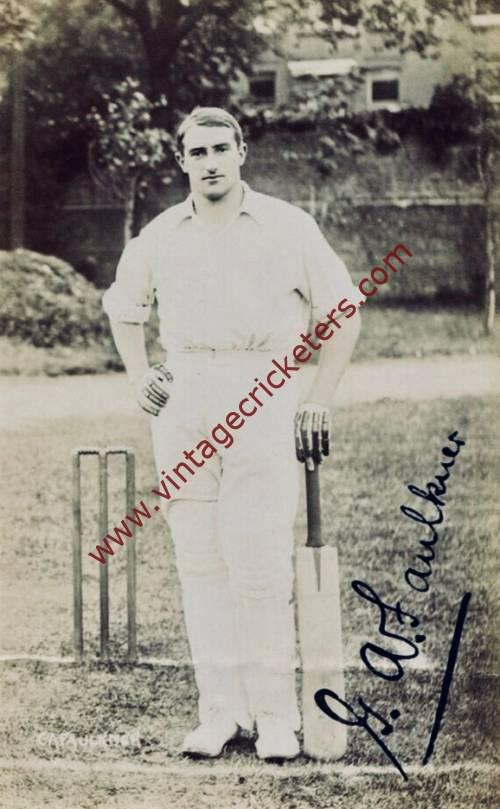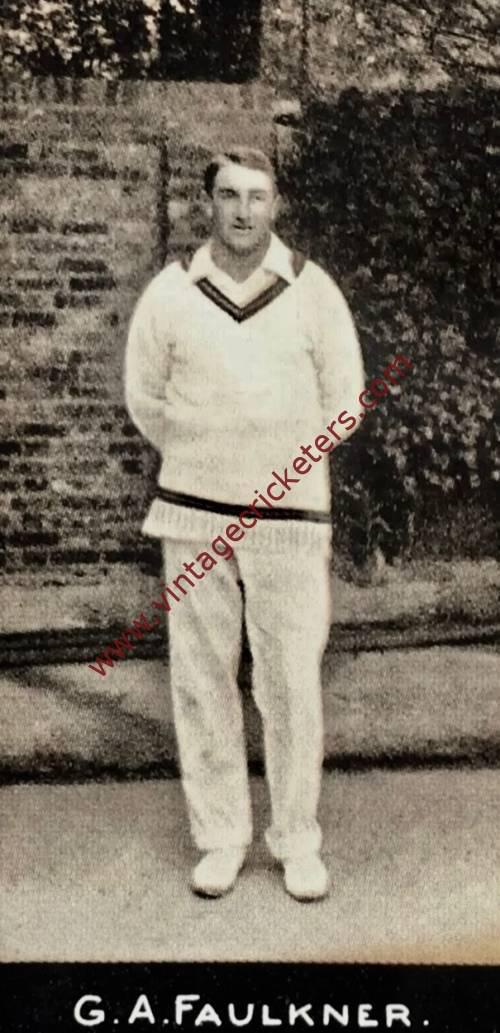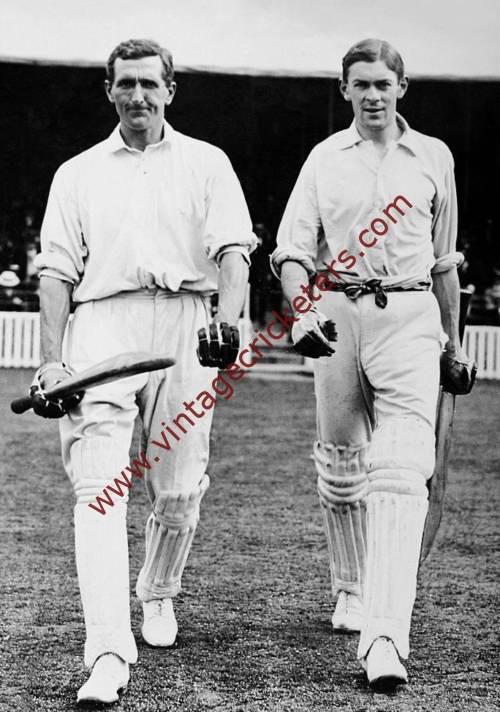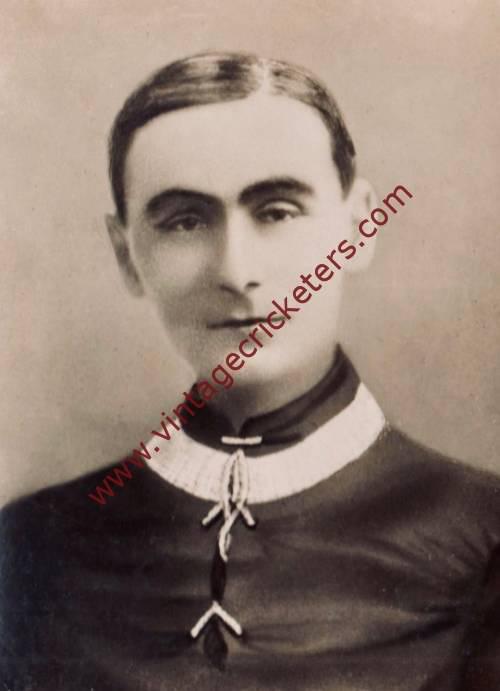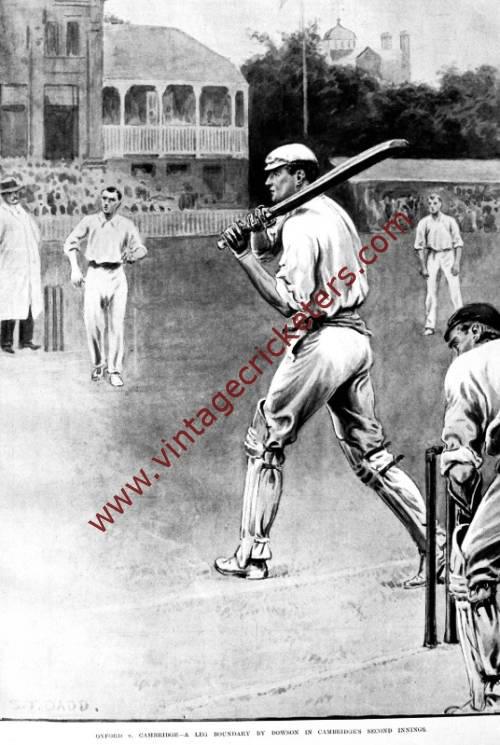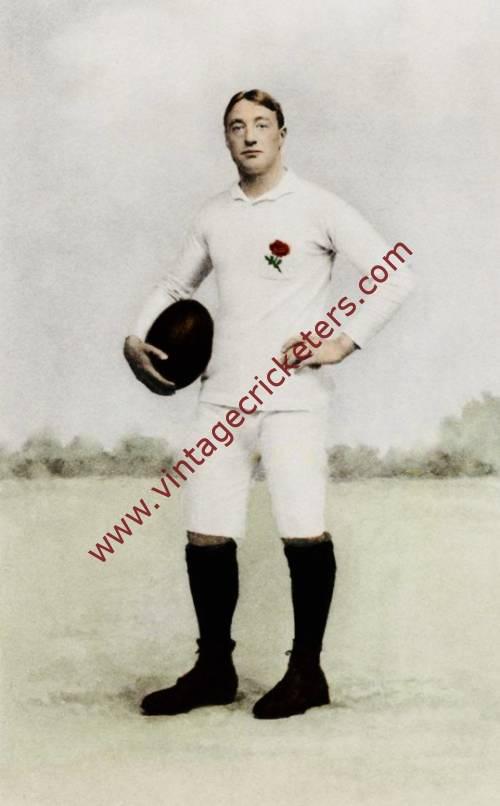Please choose your photo size from the drop down menu below.
If you wish your photo to be framed please select Yes.
Note: 16″x 20″not available in a frame.
Images can also be added to accessories. To order please follow these links
£8.95 – £49.95
Please choose your photo size from the drop down menu below.
If you wish your photo to be framed please select Yes.
Note: 16″x 20″not available in a frame.
Images can also be added to accessories. To order please follow these links
The maximum number of views of this element is reached.
Please contact the webmaster to enable unlimited views.
Port Elizabeth, Cape Province born all-rounder Aubrey Faulkner was considered one of the best all-rounders in the world during his career, having began his career as a soldier in the Imperial Light Horse and fight in the Anglo-Boer War. After the end of the War, Faulkner was given a chance to play two first class cricket matches for Transvaal in the 1902-03 Currie Cup Tournament. He batted at nine in both games and only bowled for five wicketless overs. He wasn’t seen as anything more than an average cricketer at the time and he didn’t play a match in the following season.
In 1904 Faulkner was taught how to bowl a googly by Reggie Schwarz, who had learned it from Bernard Bosanquet while on tour with the South African team in England in 1904. Faulkner came to the notice of the South African selectors when he scored a half century and took six wickets with his googlies to lead Transvaal to a surprise win over the touring 1905-06 M.C.C. side in just his fourth first class match. He was promptly selected for his Test debut in the first Test of the series against England at Johannesburg in January 1906, where he was part of a four man googly attack along with Schwarz, Bert Vogler and Gordon White. Faulkner’s match figures of 6-61 helped South Africa record their maiden Test victory, and he retained his place throughout the series, being a significant contributor to South Africa’s 4-1 series victory and at times being more difficult to play than any of the other South African bowlers.
Faulkner was selected for the South African tour of the United Kingdom in 1907 and his mastery of googly bowling, along with that of Schwarz, Vogler and White, had a significant effect on the acceptance of wrist spin as an effective bowling weapon, the highlight of the tour for Faulkner being his spell at the Leeds Test match. England were batting first and had survived to lunch with only one wicket lost. Faulkner came on to bowl after lunch, and in the span of eleven overs took six wickets for just 17 runs. During this tour the four spinners took a combined total of 228 first class wickets, with some Englishmen complaining that Faulkner’s googly was unfair because it was so hard to detect. Faulkner alone scored 1,288 runs and took 73 wickets on tour.
Faulkner didn’t play another Test match until the return of the English side to South Africa in 1909-10 for a five Test series, which saw Faulkner at the height of his skills and had many, including Wisden, calling him the best all-rounder in the world. In the first Test match of the series, Faulkner top-scored in the first innings with 78 runs, then bowled 33 overs without much rest to take 5 wickets. When he came in to bat in the second innings, South Africa were less than 30 runs ahead, but Faulkner scored his maiden Test century with 123 out of 216 scored over two hours and fifty minutes.
England were chasing 244 runs for victory, and still had two wickets in hand with 46 runs to go before Faulkner took the final two wickets of the match to give South Africa a 19 run win. Faulkner was chaired off of the ground by his teammates for his efforts. South Africa went on to win the series, and Faulkner would be their top run scorer in 5 of the 10 innings. During the series he scored 545 runs at 60.55 and took 29 wickets at 21.89, the highest run scorer from either team and the second highest wicket taker. These would be the last Test matches that Faulkner ever played in South Africa.
Faulkner then carried this batting form into his next series, against Australia in Australia in 1910-11, though his bowling suffered in comparison. The conditions in Australia were alien to Faulkner, so he shut out most of the socialising of the tour and worked on his batting in the nets. Even during the Test matches, instead of watching the match, he was practicing his batting in the nets until he had to come in to bat. In the first Test match, at the Sydney Cricket Ground, despite South Africa conceding 494 runs on the first day of the match and losing by an innings, Faulkner stood up and scored 62 and 43, the only batsman capable of withstanding the express pace of Australian fast bowler Tibby Cotter. In the second Test at the Melbourne Cricket Ground, Australia were bowled out on the first day for 348 and Faulkner came out to bat early on the second day. He passed 150, the first South African to do so in 25 years of playing Test cricket, then scored the first ever South African double century, batting well into the third day of the match. His innings of 204 lasted more than five hours and he hit twenty six fours. He played so strongly off the back foot that when his bat hit the ball it sounded like a pistol shot. It took 40 years for another South African to score a Test double century. South Africa’s 150 run first innings lead was blown away by a 159 scored by Victor Trumper faster than a run a ball. Faulkner went overly defensive in the second innings and was dismissed for 8 runs, and South Africa were bowled out for 80 to lose the match by 89 runs. Since Faulkner was the only batsman able to stand up to the Australian bowlers, he effectively became the team’s batting coach for the rest of the series. This paid off in the third Test at the Adelaide Oval, where South Africa batted well as a team, not relying on Faulkner, and won the match by 38 runs, though Faulkner was still a major contributor with a four hour long century, being out for 115. Over the five match series, Faulkner scored 723 runs, which was more than the second and third best South African batsmen combined.
Faulkner was an all-rounder, proficient with both bat and ball. According to the historical ICC Player Rankings, he was at different times the best batsman in the world and the second-best bowler in the world. Early in his career he was primarily seen as a bowler because of his great use of the googly, but later he developed into a great batsman. In Faulkner’s time, most batsmen stood side-on as the bowler approached, but Faulkner stood open and flexed his bottom hand around the grip of his bat. He had eccentric footwork in his defense, but had good technique. His strike of the ball was aggressive and powerful.
Faulkner had a stuttering bowling run-up, and as he approached the crease to bowl he would pump his elbows out wildly, similar to later fast bowler Test bowler Bob Willis. Faulkner’s bowling style was considered to be very similar to teammate Gordon White as they had almost identical in release point, flight, pace and spin, but Faulkner was the more successful of the two bowlers and was able to make the ball spin more. Faulkner’s bowling was different from his contemporary leg spin bowlers in two main ways: the ball would bounce off the pitch faster than most, and he was capable of bowling an almost undetectable googly. The faster bounce was due to Faulkner (and the other South African bowlers) generating their spin and pace more from a flick of the wrist than from arm movement. Because Faulkner’s googly was fast and hard to detect, it was almost un-hittable and often resulted in taking a wicket.
Faulkner moved to England in 1912 with the intention of playing county cricket for either Surrey or Middlesex, but businessman Julien Cahn offered him more money to play club cricket in Nottingham. In just the season of 1912 he scored 2,868 runs with an average of 84.35, including multiple double centuries, and took 218 wickets, including all ten in an innings on two different occasions. South Africa toured England again in 1912 for the Triangular Series with England and Australia, and Faulkner made himself available for South Africa, playing in six Test matches and scoring 194 runs at 19.40 and taking 17 wickets at 26.70.
Following the outbreak of the First World War, Faulkner enlisted in the British Army, joining the Royal Field Artillery, and he served on the Western Front, Macedonia and Palestine, taking part in the capture of Jerusalem. Promoted to Major, Faulkner received the DSO and the Order of the Nile for his bravery, but he contracted malaria several times during the War, which ruined his physical capabilities as a cricketer. No longer able to bowl long spells and struggling to make a living, Faulkner effectively retired from first class cricket after the War.
He played what seemed like it would be his final first class innings against a touring Australian side in 1921, making an impressive 153 runs in the first loss Australian faced on their tour. South Africa’s Test team toured England again in 1924, their first tour of England since the triangular tournament. The side failed to beat any County side in their tour matches leading up to the Test series against England, and were then destroyed in the first Test match by an innings, bowled out for 30 with the extras totalling more than any batsman. Desperate, they coerced Faulkner into joining the team for the Lord’s Test match despite him now being 42, overweight and 12 years removed from his last Test match. Faulkner’s batting was significantly worse than it had been 12 years earlier, but he still managed to score 25 runs, and while bowling he almost took the wicket of Jack Hobbs, though South African wicket-keeper Tommy Ward fumbled the ball and missed out on the stumping opportunity, leaving Faulkner wicketless for the match. In Faulkner’s 25 Test matches he scored 1,754 runs at an average of 40.79 with 4 centuries and 8 half centuries. He took 82 wickets at 26.58 apiece, with a best performance of 7-84 against England at The Oval in August 1912.
In 118 first class matches Faulkner scored 13 centuries and 32 half centuries, scoring 6,366 runs at an average of 36.58. His bowling claimed 449 wickets at 17.42 apiece, with a best performance of 7-26, claiming 5 wickets or more on 33 occasions and ten wickets in a match 8 times.
In 1925, Faulkner started a cricket school in London called the Faulkner School of Cricket, the first of its kind, and was credited with shaping some future Test players, including Doug Wright, Ian Peebles and Denis Tomlinson. The school was in a cramped reformed garage with poor electric light bulbs. Faulkner did not discriminate in his school based on class or upbringing, giving every student the same level of attention. In 1926 his book Cricket: Can it be Taught? was published. The school was never a financial success even though Faulkner would work seven days a week due to his reluctance to charge more, but it did achieve worldwide fame.
Although Faulkner had a jovial outward appearance, inwardly he suffered bouts of depression and tragically he committed suicide at the school in September 1930, aged 48.
| Weight | N/A |
|---|
